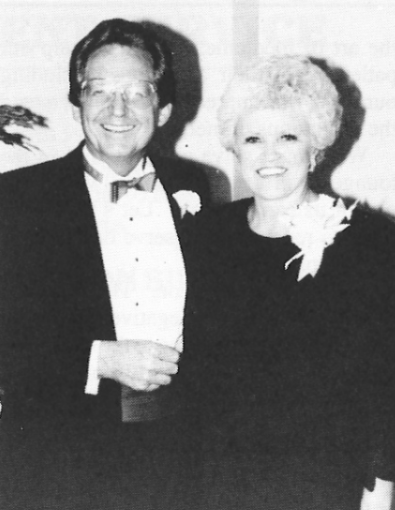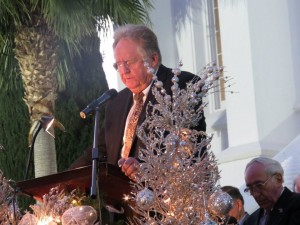ST. GEORGE — There is a little bit of Craig Booth to be found throughout St. George.

There are the trees he helped plant while a student at the old West Elementary on Tabernacle that still stand on the grounds of the 5th District Courthouse. There’s the large American flag that flies near Dixie Rock and Brooks Nature Park that Booth raised. And there’s the wellness center that bears his name on the Dixie State University campus.
But Booth’s biggest impact and legacy may be in the thousands of St. George residents that he delivered as babies and treated as children and adults as someone who was once one of just six on the medical staff of the local hospital. Booth was born and lived most of his life in St. George. He died Saturday at age 77. The cause of death has not been disclosed. Funeral services will be held Friday at 11 a.m. at the St. George Stake Center.
Booth became a well-known figure in town for being a doctor to multiple generations of Southern Utahns and an administrative leader for St. George Regional Hospital and the local water and power board. He also served several priesthood callings in his Church of Jesus Christ of Latter-day Saints ward and stake.
But the titles aren’t Booth’s legacy as much as many of the people of St. George who called him doctor.
By his own estimation, Booth said he helped “1,000 mothers deliver 2,000 children” in town and continued to be a part of their lives from check-ups to stitching up cuts.
In a 2002 article in St. George Magazine, Booth said he was guilty as charged as far as staying involved in his patients’ lives after they left the hospital.
“People sometimes talk about patients falling in love with their doctors. In reality, doctors fall in love with their patients,” Booth said.

Booth’s 43 years as a member of the staff of what is now St. George Regional Hospital is the longest of anyone, and he served as the first medical director when the facility – then at 400 South – was renamed Dixie Regional Medical Center in 1990 and served in that capacity from 1988 until 2002.
“His desire to serve in a leadership capacity came just as growth was taking off in St. George,” said Mitch Cloward, the administrator of St. George Regional Hospital. “The administrator at the time, Steve Wilson, recruited Craig to grow our first medical staff from that of a small community hospital to a major tertiary level hospital that could begin doing open-heart surgery. His insights shaped much of the clinical planning for the River Road hospital’s opening in 2003, and he did all of this and much more with great humor, effort and love.”
The passing has produced an outpouring of memories on the social media outlets Booth had frequented himself in the last years of his life, including a Facebook page created just for residents to provide their memories of “Doc Booth.”
“I quit having babies when he quit delivering them,” one resident wrote on Facebook.
Another said, “He quit delivering babies shortly after he delivered our triplets. Said he couldn’t top that. I just recently discovered he was the one who anonymously paid their hospital bill all those years ago.”
One 49-year-old resident told St. George News an incident from when she was 10, accidentally sitting on the sharp side of seven-inch scissors, saying to calm her as he stitched her up, he sang, “She’s got freckles on her butt, I love her.”

Booth’s own recent posts on Facebook give just a glimpse of the sense of humor that many said was just as effective a medicine as anything else he prescribed as a physician.
In April 2020, he wrote about still taking miles-long daily bike rides around town. But it wasn’t for his health or the scenery.
“I still ride my bicycle around 15 miles every day not for the exercise, but for the off chance someone will stop me in the middle of a street and shoot the bull for a few minutes,” Booth wrote. “Stop me please if you see me. Ask me anything but expect at least a 30-minute answer regardless of the topic, the location, or the time of day or night.”
In November, he wrote, “I am in mourning tonight! I was not named the “Sexiest Man Alive” by People Magazine for the 20th straight year! How can they do this to me?” And for his birthday two months ago, he wrote, “I appreciate all the birthday wishes. I have great friends and people who owe me money.”
Cloward said there is no question Booth had an impact far beyond the hospital. “He loved and served others with everything in him,” Cloward said. “Craig was one of a kind, a true friend to all, and we miss him.”
A life dedicated to helping others
Booth was born Feb. 22, 1944 to Fred and Marie Lang Booth at St. George’s original hospital, the McGregor Hospital, at 100 East and Tabernacle. He grew up watching West Elementary be built right next to his small home at the site of what is now the 5th District Courthouse.

According to the St. George Magazine article, Booth said he took on his first leadership role in his junior high years at the nearby Woodward School, acting as “police chief” of the hall monitors. There, he came to the aid of a younger seventh grader named Maureen Haslam. “This mean, older kid was chasing me and Craig played the hero and saved me,” Maureen said in the St. George Magazine article.
Booth said devoting a life to helping others began on the football field at Dixie High, where he lettered in both football and basketball. Just before an Oct. 27, 1961, game at Milford High, Booth’s teammate and best friend Wendell Hafen came out with the team, turned in a half circle and collapsed on the field.
Booth helped Dixie High coach Walt Brooks try to revive his friend. There was nothing they could do.
“It was a horrible experience because I didn’t know what I was doing. He didn’t make it. But it was one of the contributing causes to why I became a physician,” Booth said in a 2019 presentation by Intermountain Healthcare. “There were other things that happened to me that made me want to not feel like that again when I came upon someone that needed drastic help.”
Booth moved on to Dixie Junior College and was on the honor roll for each quarter he attended, doing pre-med work. He also rekindled the friendship with Maureen, the underclassman he rescued back in junior high.
She became Maureen Booth on Aug. 5, 1967. Shortly after, her junior high hero became a 1971 graduate of the University of Utah Medical School.
Returning home
After doing a year of interning at UCLA-Harbor General Hospital in Los Angeles, Booth said in the St. George Magazine article he was recruited to return to town in 1973 as the sixth member of the medical staff of what was then Dixie Pioneer Memorial Hospital.
“I was halfway through the program to become a surgeon when Dr. (Clark) Staheli and Dr. (Norman) Fawson recruited me,” Booth said. “The Chief of the Department at UCLA tried to talk me out of leaving. He said I’d get too involved treating friends and neighbors in St. George and lose my objectivity in their treatment. Somehow, though, I knew coming home was the right decision.”

In a 2016 St. George News article, Booth described the facilities at what is now the parking lot of the 400 East Campus of St. George Regional Hospital as “inadequate” where there were just 41 beds and no need for an intercom system since staff could hear each other across the long hallway.
That began a medical career that saw Booth deliver babies that would later be some of his colleagues as Dixie Pioneer Memorial became the bigger Dixie Memorial at 400 East, then Dixie Regional Medical Center and St. George Regional Hospital at River Road – all of which Booth played a role in shaping as a doctor and, later, an administrator.
His other medical accomplishments include being named as Utah Doctor of the Year in 1994 by the Utah Medical Association, for which he served as president from 1988 to 1989 – with then-Gov. Mike Leavitt honoring him in a ceremony.
Outside the medical field, he was a founding member of the St. George Exchange Club and sat on the St. George Water and Power Board, where he had the large American flag erected next to the water tank on Skyline Drive that can be seen throughout the city.
His faith in the LDS Church was also a big part of Booth’s life, serving as a worker at the St. George Temple, a bishop at Dixie State and from 2002 to 2005 was the mission president of the Arizona Phoenix Mission.

He also lived up to the adventure of Southern Utah, obtaining a pilot’s license and plane, as well as hiking The Subway in Zion National Park more than 100 times. According to Maureen Booth in the St. George Magazine article, one of those returns from The Subway was more eventful than the others.
“He came in the house and said, ‘I think I’m having a heart attack, but I’m not sure.’ He insisted on driving himself to the hospital,” Booth said of her husband after one hike on the left fork of North Creek. “When he arrived, instead of seeing the ER doctor, Craig found the EKG technologist and talked him into hooking up the equipment. Craig read the results himself.”
He retired from his medical practice in name only in 2016, still helping patients at the Doctor’s Volunteer Clinic and helping establish the Booth Wellness Center at his Dixie State alma mater. And he could still be seen around town on his bike, trying to strike up conversations with his trademark Diet Coke in hand.
And of all of those people, places and things he touched in St. George , he joked in a Facebook post last year at the start of the pandemic that there is one more way he can still show his love to his neighbors – even if he could no longer greet them in person.
Look to the west after sunset … at the Black Hill, Booth said. At the “D” lights.
“If you can see the “D” on the hillside so bold, you will notice one lonely red light in the lower left hand corner,” Booth said. “That is me shining a light on everyone I love.”
Booth is survived by the woman he rescued in junior high and wife of 53 years, Maureen, as well as their five children and 15 grandchildren.
Copyright St. George News, SaintGeorgeUtah.com LLC, 2021, all rights reserved.